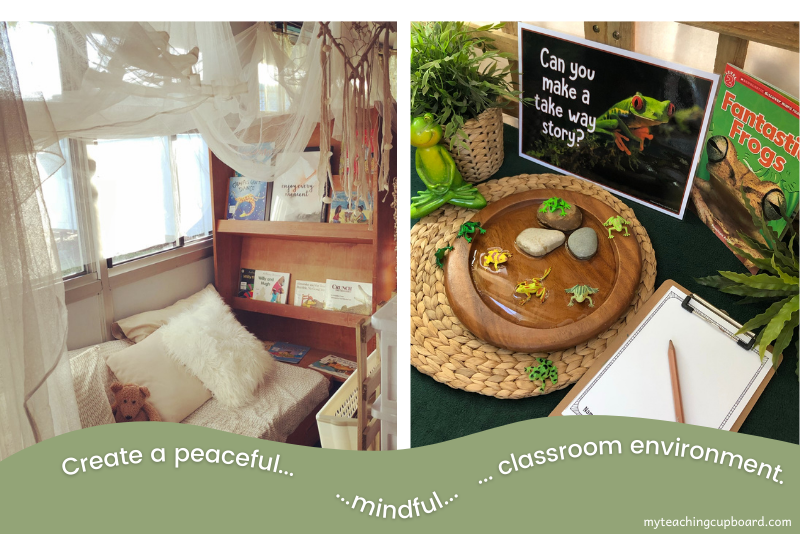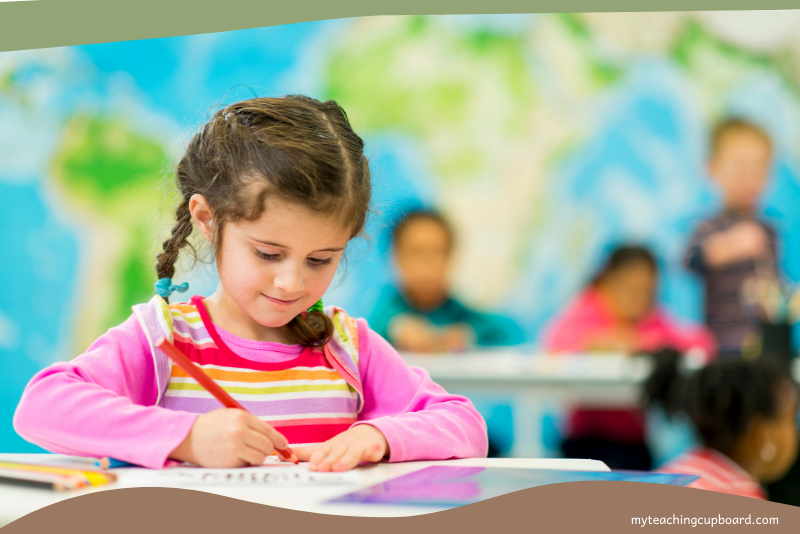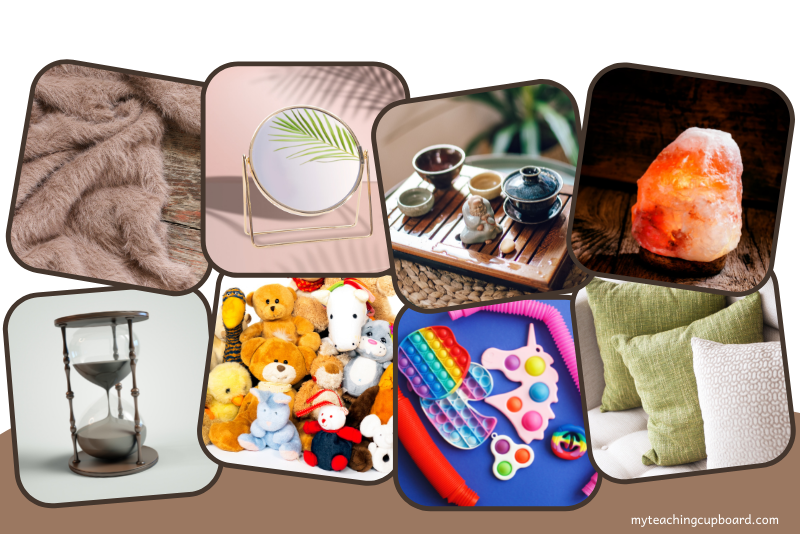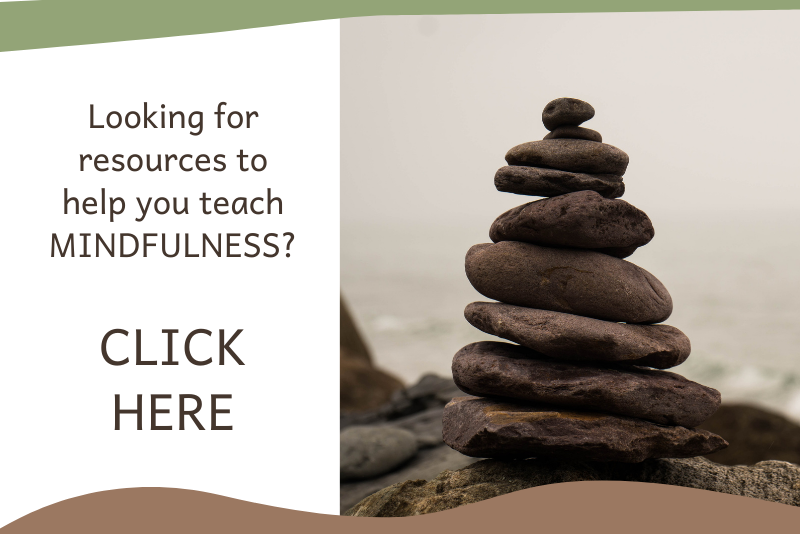Creating a Mindful Classroom
If you are looking for a way to create a mindful classroom, this blog post might help you. When you nurture mindfulness in your classroom, your children will be focused and present in their learning. Don’t all teachers want that!!
A calmer mind leads to a calmer and more productive classroom environment.
Before we look at some simple tools and strategies for teaching mindfulness in the classroom, let’s discover what mindfulness is.
What is mindfulness?
When you are mindful, you are paying full attention. Your mind is full of awareness - you are completely aware of where you are and what you are doing.
When you are practising mindfulness, you slow down and focus your attention on the present moment.
If you want your children to practise being mindful, there are 3 things they need to master:
Stop doing anything else but the task at hand
Focus on their breath – breathe naturally
Pay full attention, with all their senses, to what they are doing
It sounds simple enough but don’t be misled. Practising mindfulness is an art and can sometimes be quite difficult in our over stimulating world. Our classrooms are often over stimulating too. Both teachers and students are often expected to complete tasks quickly and efficiently. All this leads to a stressful and rushed lifestyle.
Mindfulness is all about slowing down and creating a less stressful and calm environment and lifestyle. Creating a mindful classroom and teaching mindfulness to your children is well worth the time and effort. There are many benefits to cultivating mindfulness in the classroom.
The Benefits of Mindfulness for Children
When you teach mindfulness to your children, they will be able to develop an awareness of themselves and their environment. Through practising mindfulness your children will begin to understand their emotions and their attentiveness.
Mindfulness is a tool your children can use to build their confidence and resilience. Teaching mindfulness to your children can also help to develop their executive functioning skills.
Advanced executive functioning skills are necessary to undertake tasks like planning, reasoning, problem-solving, and the development of positive social relationships. In a mindful classroom you can expect to see your children starting to master basic executive functioning skills like
paying attention
remembering important information
the ability to shift between tasks
self-regulation
behaving appropriately with others
conflict resolution
Does this all sound too good to be true? Creating a mindful classroom is pretty good and does have amazing benefits but it takes time and commitment.
Your time and commitment will be rewarded though. A mindful classroom is a pure joy to work in. It will not only provide you and your children with a better learning environment, but your children are also going to benefit mentally, psychologically, socially and physically.
Part of the reason why mindfulness is so effective for children can be explained by the way the brain develops. While our brains are constantly developing throughout our lives, connections in the prefrontal circuits are created at their fastest rate during childhood. Mindfulness, which promotes skills that are controlled in the prefrontal cortex, like focus and cognitive control, can therefore have a particular impact on the development of skills including self-regulation, judgment and patience during childhood. Mindfulness for Children
With heightened academic pressure trickling down to kids as early as kindergarten, resulting in less time for play and the arts, children today are faced with an unprecedented amount of stress and anxiety—25% of 13- to 18-year-olds will experience an anxiety disorder according to the National Institutes of Mental Health. Such early stress levels can negatively impact learning, memory, behavior, and both physical and mental health, according to the American Academy of Pediatrics.
Mindfulness is so beneficial for children. The latest research indicates mindfulness can help children improve their abilities to pay attention, to calm down when they are upset and to make better decisions. This research also found that children practising mindfulness were using it as a tool to help with their emotional regulation and cognitive focus too.
How to Create a Mindful Classroom
A mindful classroom is a constant work in progress. The task of creating a mindful classroom is a bit like teaching – the job is never done. It is a wonderful journey though and even just a little bit of mindfulness can go a long way.
Here are a couple of mindfulness lessons and activities you can use to get you started.
Add Mindfulness to Your Classroom Routine
If your classroom is anything like mine, it runs on routines and procedures. Adding a mindful activity or two to your daily timetable will be a productive commitment you can make on the journey to creating a mindful classroom.
You only need 5 minutes for an effective classroom mindfulness activity. You can set aside 5 minutes in your morning meeting, or as a short settling down activity after first or second break. We do all three = 15 minutes every day and it pays!!
Here are some short (and very much loved by my class) classroom mindfulness activities:
Belly Breathe – The children find a comfortable place to lie down somewhere in the room. They close their eyes and put their hands on their diaphragm. As they breathe they can feel their hands gently rising and lowering. Ask them to pay attention to their breathing and notice their feelings. You might like to play relaxing music while they do this. After a couple of minutes (maybe only 1 minute to start with), I like to do a turn-and-talk so they can share their thoughts and feelings with a friend.
Teddy Bear Breathing - This mindfulness activity is an extension to the above belly breathing one. Each child needs a small teddy bear or soft toy. At a pinch, I have used small manipulatives like unifix blocks or other math manipulatives instead of a teddy bear. The children lie down and breathe just like for belly breathing but instead of placing their hands on their diaphragm, they instead place their small toy on their diaphragm. They can mindfully watch their toy slowly moving up and down as they breathe.
Shape Breathing – This mindfulness activity is great for settling the class – you know for those high energy times and on windy days!! We rarely make it through the day without doing a quiet shape breathing exercise – windy or not. Together with the children, you slowly draw a rectangle shape in the air with your finger. As you make the first side you all breathe in. Then hold the breath as you make the next 2 sides of the rectangle. On the last side of the rectangle, you all slowly breath out. To sneak in some math and add a bit of variation, you can change your shape. Squares and triangles work well.
The Listening Triangle – The children sit cross legged on the floor. I ding a triangle. This is the signal for them to close their eyes and listen carefully to the soft sound of the triangle fading away. When they can no longer hear the resonating sound of the triangle, they open their eyes. We usually repeat this a couple of times.
Classroom Yoga – Cosmic Kids on You Tube is our go-to. There are a number of age appropriate yoga adventures on this You Tube channel. They vary in length. If you want to include yoga as a mindfulness activity in your classroom, each child in your class will need to have enough space to freely move without hitting furniture or each other.
Create a Peace-Out Mindfulness Area
A peace-out mindfulness area is a dedicated calm quiet area in your classroom. This is NOT a time-out area. It should be an inviting place where your children want to go to. It is a place where they can practice mindfulness, calm down, relax and … peace-out.
A calm down space or peace-out corner should be a welcoming place your children can go to whenever they have the need to take a break or calm their emotions. This area is where your children will begin to develop their self awareness and self regulation skills.
A peace-out mindfulness area should have soft textures and calming colours. You might also like to provide calming materials that encourage positive behaviours and mindfulness.
Some items you could add to your classroom mindfulness area are: soft cushions, soft textured blankets, stuffed animals, mindfulness books, fiddle toys, plants and soft lighting. I have some growth mindset posters and positive affirmations you can print and display in your peace-out mindfulness area if you like.
Try not to clutter the space. It is much better to have just a few items in the area. You don’t want it to be a distracting or over stimulating space. I like to keep a back-up basket of mindfulness resources in the storeroom and switch them out regularly.
If you want this area to be successful, you must spend some time discussing the space and its purpose with your children. Discuss and set clear boundaries about how and when the children can use the peace-out area. You might like to consider how long children can stay there, how many children can use the space at any one time and possible re-setting rules.
THINGS TO ADD TO A MINDFULNESS AREA: sand timers, soft stuffed animals, fidget toys, cusions, soft and textured blankets, meditation cards, acrylic mirror, zen & mindfulness ornaments, soft lighting, a canopy, books about mindfulness, sensory bottles, mindfulness quotes & posters
As you prepare to create a mindful classroom, consider practising mindfulness yourself. The best way to teach a child to be mindful is to be a mindful teacher. Modelling mindfulness is the most effective strategy.
Being a teacher is pretty stressful. I am sure my conscious effort to practice mindfulness has helped me be less stressed in this profession and it has certainly helped me to be a better teacher. I am sure mindfulness can help you too.
I hope this blog post has given you some insight into how to create your own mindful classroom and develop the emotional learning of your students. I hope you also find a way to welcome and practice mindfulness in your own life too– personally and professionally.
Mindfulness practice leads to a calmer and more productive classroom environment.
Mindfulness practice leads to a calmer and more productive teacher.
Mindfulness practice leads to a calmer and more productive child.
If you liked this blog post about creating a mindful classroom, please consider sharing it...
Just CLICK the sharing box below.👇















